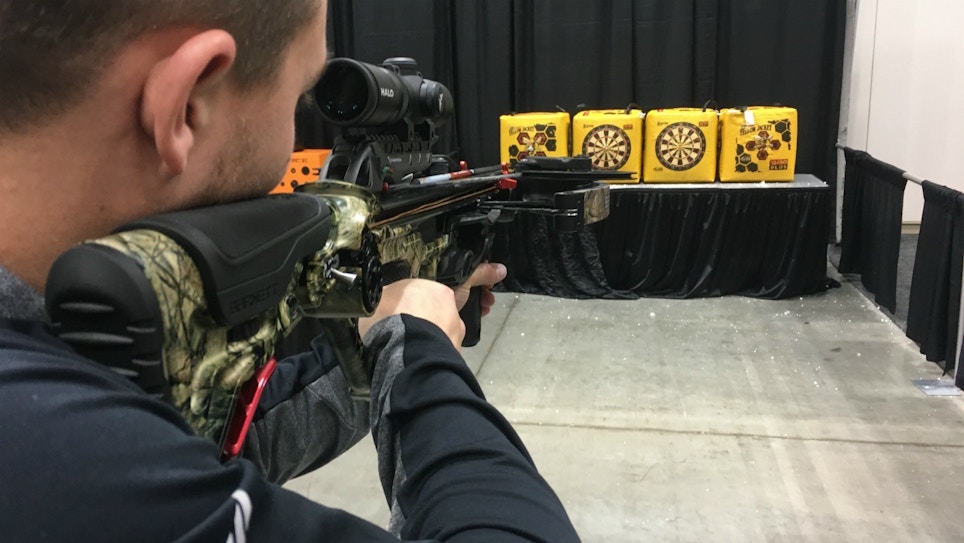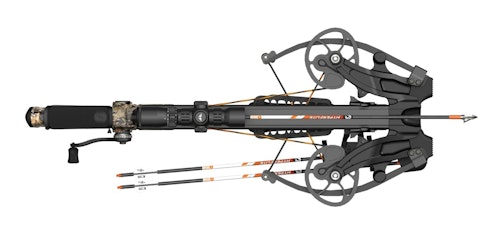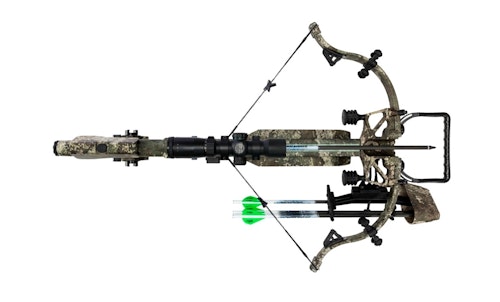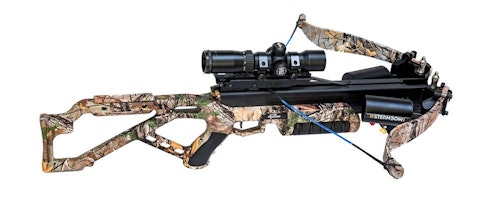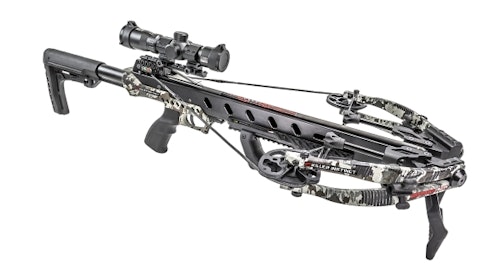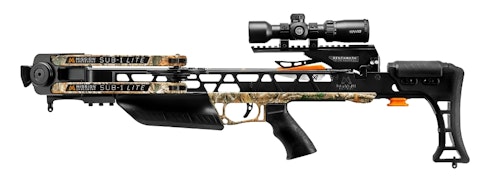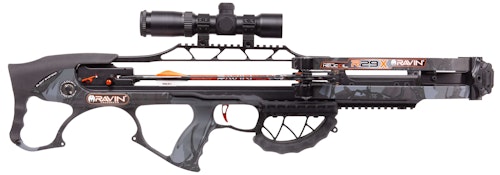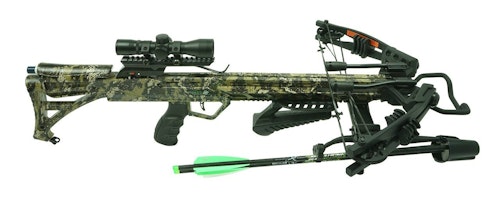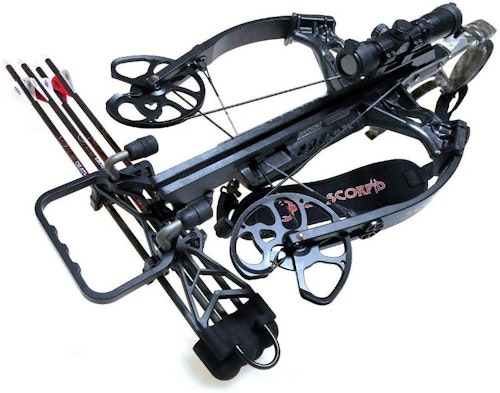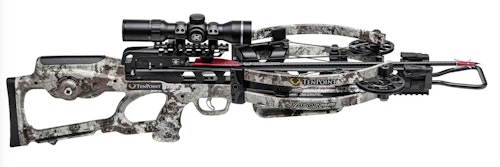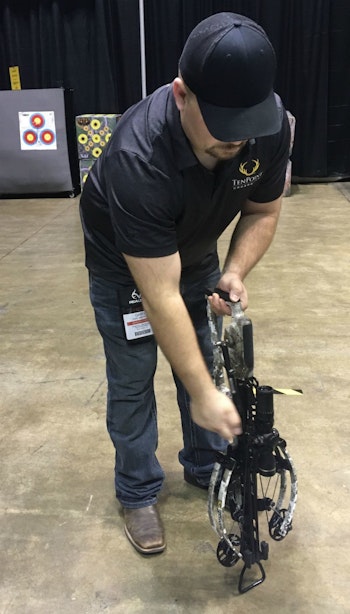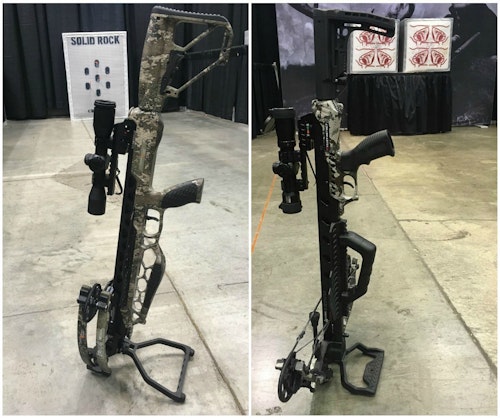As an avid bowhunter, I look forward each January to the annual Archery Trade Association (ATA) Show. The 2020 event was recently held at the Indiana Convention Center in Indianapolis, and I spent three days walking the 510,000 square-foot show floor and meeting with industry experts. In addition to talking about gear, however, attendees can test bows — compounds, crossbows and traditional bows — at the many shooting lanes located on the outer rim of the exhibit floor. During the final day of the 2020 ATA Show, I specifically searched the shooting lanes for crossbows.
Below, listed in alphabetical order, are 10 crossbows that caught my eye. You can visit the companies’ websites for detailed bow specifications, so instead of simply restating these facts and figures, I will provide my opinions after examining each model in person.
Important note: Don’t confuse my reviews with a deep-dive field test conducted over several days, weeks or months. I took exactly two shots with each bow and then jotted down my notes. That said, even though I can’t speak to durability, or for that matter accuracy, it doesn’t take more than a couple shots to get a feel for a crossbow. FYI: These test bows have been set up by the manufacturer, but that doesn’t necessarily mean each one will be dead-on at the shooting lane distance of about 12 yards.
I chose to make this a two-shot test instead of a single-shot affair because of the wide variety of crossbow trigger styles. For me, shot No. 1 allowed me to learn a specific trigger’s travel and poundage before sending a second arrow downrange. With this first-shot trigger knowledge, I could really focus on vibration, recoil and other takeaways during shot No. 2. In other words, I could anticipate when a crossbow would actually fire as I pressed the trigger rearward, and I wouldn’t be surprised by the firing of the bow.
Barnett HyperFlight EVO 420 ($1,599.99/package)
The HyperFlight crossbow was announced during ATA 2019, but because it was still in prototype stage, I couldn’t shoot it. This year it is ready to hit the market.
The first thing you’ll notice about the HyperFlight EVO 420 is its unique riser-mounted cam system. Unlike any other crossbow, the cams aren’t attached to the limbs; they’re on the riser. According to Barnett, this eliminates cam lean and torque, resulting in never-before-seen accuracy.
Because of the bow’s weight (10.9 pounds), I think a shooting rest is mandatory. I take 100 percent of my crossbow shots on game with aid of a shooting rest. I prefer a tripod when hunting on the ground, and a monopod works best for me in a treestand. The trigger is good, and according to a spokesman from Barnett, the new cam system, coupled with the company’s innovative HyperFlight small-diameter arrow, dramatically improves penetration.
CenterPoint CP400 ($799.99/package)
According to the CenterPoint product engineer working in the ATA 2020 shooting lanes, the CP400 has an improved cocking sled from 2019, which results in longer server and string life. One interesting feature on the CP400 is the foot stirrup, which folds down at a 90 degree angle. In this position, the stirrup can be used to balance the bow vertically on the ground (see photo at bottom of page), and it serves as a shooting platform (think attached bipod) when shooting from a bench. When cocked, the CP400 is only 6 inches wide. The bow’s forearm is flat and wide, making it ideal for the yokes on most monopods, bipods and tripods.
Excalibur Assassin 400TD ($1,799.99/package)
In my ATA 2019 crossbow recap, I discussed the Assassin 420TD (TD = Take Down) with recurve limbs. The 400TD is the company’s micro platform, and it features high-output recurve limbs. I like this bow’s quick and simple adjustable stock and cheek piece, and it has a decent two-stage trigger. Make no mistake: Even though this a recurve crossbow, it’s fast, pushing arrows downrange at up to 400 fps. If you live by the “keep it simple, stupid” mantra, then check out the Excalibur Assassin 400TD.
FYI: Excalibur recurves are used as the platform for Steambow crossbows (photo below), which are cocked and uncocked with the power of compressed air (think paintball tanks). Click here to see it in action.
Gearhead X16 Target ($2,099/bow only)
Each time I shoot a Gearhead crossbow I’m more impressed. During ATA 2020, I shot the target version of the X16 series. This one-piece machined aluminum crossbow (it doesn’t quickly disassemble into two parts like the X16 Tactical) has a Bodoodle arrow rest (the X16 Tactical has a Whisker Biscuit) and a Trigger Tech trigger box. I’ll let you visit the company’s website for more on Trigger Tech, but let me state plainly: This bow has an outstanding single-stage trigger. When you begin to press the 2.1-pound trigger, the bow cleanly and quickly releases the arrow. It feels like a topnotch trigger on an expensive bolt-action rifle.
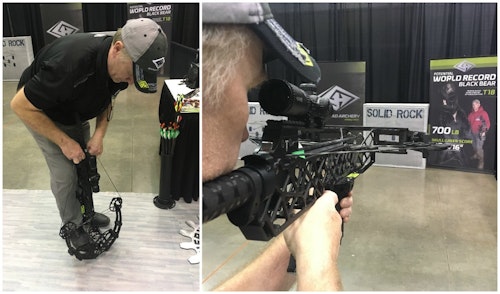
Killer Instinct Speed 425 ($549/package)
Featuring an adjustable rear stock, 200-pound limbs, aluminum rail and a decent trigger, the Killer Instinct Speed 425 is fast (425 fps) and affordable. For a hunter who wants a fast crossbow without paying two, three, four or even five times more, the Killer Instinct Speed 425 might be the answer. I liked the bow’s large foot stirrup, which allows the Speed 425 to stand vertically on the ground, and at only 7.2 pounds, it felt good aiming even without a shooting rest.
Mission Sub-1 Lite ($1,399.99 - $1,499.99/package)
The Mission Sub-1 Lite balances beautifully in the hand and has an adjustable stock (length of pull and comb) to make it easy for any shooter to look directly into the scope. I like the bow’s forearm, which is flat, wide and sticky, making it great for use in the yoke of a shooting stick. This bow doesn’t have a foot stirrup that protrudes from the bow, which enables a bowhunter to hold the Sub-1 Lite close to the wall of a ground blind without interference. It has a lightweight (3.3 pounds) and crisp trigger. The Sub-1 Lite weighs only 6.9 pounds, is comfortable to shoot and pushes arrows up to 335 fps.
Ravin R29X ($2,649.99/package)
Featuring thicker limbs than the Ravin R29, the R29X sends arrows downrange at up to 450 fps. The “X” version also has a new fully integrated silent cocking system. This crossbow balances well when shouldered, and its trigger is truly outstanding. The R29X measures 29 inches in length and is 6 inches wide (axle to axle) when ready to shoot. It weighs only 6.75 pounds. Like every Ravin crossbow I’ve seen, the fit and finish is exceptional. Observation: Nearly everyone I watched who shot the Ravin R29X in the shooting lane during ATA 2020 had the same “I can’t believe how sweet this thing is” expression.
Rocky Mountain 415 ($349.99/package)
This is a new series of crossbows from parent company FeraDyne; it replaces the now discontinued lineup of Carbon Express crossbows. (I’ve owned a couple Carbon Express crossbows, and they always worked very well for me.) The feel and function of the Rocky Mountain 415 reminded me of previous Carbon Express bows, and this is a good thing. The trigger, while it has considerable travel, does break cleanly and crisply after you hit the back wall. Because I’ve shot so much with my Carbon Express crossbows, the trigger on the Rocky Mountain 415 felt very familiar, and I’m confident I could drive tacks with it on the archery range. Delivering arrows up to 415 fps, this bow is plenty fast, too.
Scorpyd Death Stalker 420 ($1,132.95/package)
With a draw weight of 130 pounds and speed of 420 fps with 370-grain arrows (about 405 fps with 400-grain arrows), the Scorpyd Death Stalker 420 is an interesting reverse-draw crossbow. First, I think you’ll be surprised by the bow’s overall weight, which is only 6.2 pounds. When the Scorpyd staffer handed the bow to me at the shooting line, I expected it to weigh a lot more. The Death Stalker 420 has a fantastic single-stage Kempf Tech Integrated Trigger. I can’t find trigger pull specs published anywhere online, but my guess is 3 pounds.
TenPoint Vapor RS470 ($2,949.99 - $3,049.99/package)
Few bows received as much preshow publicity as the TenPoint Vapor RS470. The reason is TenPoint has raised the bar several times through the years when it comes to crossbow innovation and performance, and expectations were high as attendees finally got the chance to handle and shoot the new RS470. This reverse-draw crossbow balances beautifully in the hands when aiming, and like all TenPoint bows, the fit and finish is flawless.
The big news regarding the TenPoint Vapor RS470 is the new ACUslide cocking system, which in terms of a letter grade, gets an A+ from me. It’s smooth, silent and you can release the handle on the ACUslide at any time during cocking or uncocking and it doesn’t move. Period. This bow is super-fast, up to 470 fps, and it has a new (and nice) S1 two-stage trigger.
Final Thoughts
As I stated earlier, this review isn’t a deep dive into these 10 crossbows. I fired exactly 20 arrows under controlled conditions inside the Indiana Convention Center. Even though I can’t speak to the accuracy of these specific bows, from my experience, any modern crossbow when shot from a solid rest will stack arrows (I prefer a tripod whenever possible). In fact, I recommend not shooting at a single bull’s-eye at 20 yards and less because you’ll likely damage arrow nocks, fletching and shafts. After sighting in any of these crossbow/scope combos, I would expect that at 20 yards, you could hit a bull’s-eye the size of quarter almost every time.
If you’re new to crossbow shooting and hunting, you might be surprised at the noise when firing a crossbow. Due to the heavy poundage, short limbs and other factors, crossbows are significantly louder than compounds. (And for what it’s worth, compounds are louder than traditional bows.) I’m sure the decibel ratings for the 10 bows discussed here vary considerably, but I didn’t walk away from my test thinking, Wow, that model was really loud (or quiet). In addition, different parts of the Indiana Convention Center vary tremendously in noise level depending on what’s happening in nearby exhibitor booths. Because the shooting lanes are spread throughout the show in at least four spots, it’s impossible to talk about crossbow noise from my limited indoor test.
Finally, when it comes to triggers, I’ll say that my favorite three (in order of preference) were found on the Gearhead X16 Target, Ravin R29X and Scorpyd Death Stalker 420. Each of these bows features single-stage triggers (no creep) and break as you’d expect on a fine bolt-action rifle.
